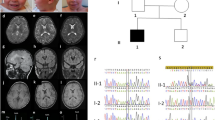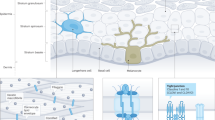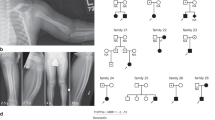Abstract
We recently mapped the disease locus for severe autosomal recessive lamellar ichthyosis (LI) to chromosome 14q11 and showed complete linkage with TGM1, the gene encoding transglutaminase 1. We have now identified point mutations in TGM1 in two of the multiplex LI families used in the linkage study. Each nucleotide change causes a non–conservative amino acid substitution of histidine for one of two adjacent arginine residues in exon 3 of the gene (Arg141His, Arg142His). Within the transglutaminase family, these arginines are invariant within a conserved region, distant from the catalytic site of the enzyme. We hypothesize that these mutations adversely affect formation of crosslinks essential in production of cornified cell envelopes and a normal stratum corneum layer of the skin.
This is a preview of subscription content, access via your institution
Access options
Subscribe to this journal
Receive 12 print issues and online access
$209.00 per year
only $17.42 per issue
Buy this article
- Purchase on Springer Link
- Instant access to full article PDF
Prices may be subject to local taxes which are calculated during checkout
Similar content being viewed by others
References
Russell, L.R., DiGiovanna, J.J., Hashem, N., Compton, J.G. & Bale, S.J. Linkage of autosomal recessive lamellar ichthyosis to chromosome 14q. Am. J. hum. Genet. 56, 1146–1152 (1994).
Cheng, J. et al. The genetic basis of epidenrmolytic hyperkeratosis: a disorder of differentiation-specific epidermal keratin genes. Cell 70, 811–819 (1992).
Foundation for Ichthyosis and Related Skin Types. Ichthyosis. an ovenriew. 3–9 (FIRST, North Carolina, 1987).
Reichert, U., Michel, S. & Schmidt, R. The cornified envelope: a key structure of terminally differentiating keratinocytes. in Molecular biology of the skin, (eds Darmon, M. & Blumenberg, M. 107–150 (Academic Press, California, 1993).
Steinert, P.M. A model for the hierarchical structure of the human epidermal cornified cell envelope. Cell Death different. 2, 23–31 (1995).
Kim, I.G. et al. Structure and organization of the human traneglutaminase 1 gene. J. biol. Chem. 267, 7710–7717 (1992).
Yee, V.C. et al. Three-dimensional structure of a transglutaminase:Human blood coagulation factor XIII. Proc. natn. Acad. Sci. U.S.A. 91, 7296–7300 (1994).
Kim, S.-Y., Kim, I.-G., Chung, S.-I. & Steinert, P.M. The structure of the transglutaminase 1 enzyme. J. biol. Chem. 269, 27979–27986 (1994).
Pedersen, L.C. et al. Transglutaminase factor XIII uses proteinase-like catalytic triad to crosslink macromolecules. Protein Sci. 3, 1131–1135 (1994).
Kamura, T. et al. Deficiency of coagulation factor XIIIA subunit caused by the dinucleotide deletion at the 5′ end of exon III. J. din. Invest 90, 315–319 (1992).
Standen, G.R. & Bowen, D.J. Factor XIII ABristol 1: Detection of a nonsense mutation (Arg171→stop codon) in factor XIII a subunit deficiency. Br. J. Haematol. 85, 769–772 (1993).
Mikkola, H. et al. Deficiency in the A-subunit of coegulation factor XIII: two novel point mutations demonstrate different effects on transcript levels. Blood 84, 517–525 (1994).
Board, P., Coggan, M. & Miloszewski, K. Identification of a point mutation in factor XIIIA subunit deficiency. Blood 80, 937–941 (1992).
Traupe, H. The lamellar ichthyoses. in The Ichthyoses: A guide to clinical diagnosis, genetic counseling, and therapy. 111–134 (Springer, Berlin, 1989).
Brocq, L. Erythrodermie congenitale ichthysiforme avec hyperepidermotrophie. Ann. Dermatol. Syph. (Paris) ser 4, 3, 1–31 (1902).
Gentile, V., Davies, P. & Baldini, A. The human tissue transglutaminase gene maps on chromosome 20q12 by in situ fluorescence hybridization. Genomics 20, 295–297 (1994).
Wang, M., Kim, I.-G., Steinert, P.M. & McBride, O.W. Assignment of the human transglutamiriase 2 (TGM2) and transglutaminase 3 (TGM3) genes to chromosome 20q11.2. Genomics 23, 721–722 (1994).
Sambrook, J., Fritsch, E.F. & Maniatis, T. Molecular Cloning: A Laboratory Manual. 2nd edn (Cold Spring Harbor Laboratory, New York, 1989).
Richards, B. et al. Multiplex PCR amplification from the CFTR gene using DNA prepared from buccal brushes/swabs. Hum. molec. Genet 2, 159–163 (1993).
Author information
Authors and Affiliations
Rights and permissions
About this article
Cite this article
Russell, L., DiGiovanna, J., Rogers, G. et al. Mutations in the gene for transglutaminase 1 in autosomal recessive lamellar ichthyosis. Nat Genet 9, 279–283 (1995). https://doi.org/10.1038/ng0395-279
Received:
Accepted:
Issue Date:
DOI: https://doi.org/10.1038/ng0395-279
This article is cited by
-
Development of peptide-based biosensors for detecting cross-linking and deamidation activities of transglutaminases
Amino Acids (2023)
-
Clinical and genetic investigation of ichthyosis in familial and sporadic cases in south of Tunisia: genotype–phenotype correlation
BMC Medical Genomics (2022)
-
Steroid sulfatase deficiency causes cellular senescence and abnormal differentiation by inducing Yippee-like 3 expression in human keratinocytes
Scientific Reports (2021)
-
Inherited Nonsyndromic Ichthyoses: An Update on Pathophysiology, Diagnosis and Treatment
American Journal of Clinical Dermatology (2018)
-
Characterization of TG2 and TG1–TG2 double knock-out mouse epidermis
Amino Acids (2017)



